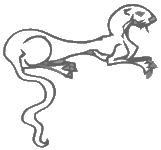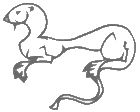 |
 |
 |
 |
 |
 |
 |
 |



Otter Evolution
Lutrinae
Southern river otter (Lontra provocax)
Neotropical river otter (Lontra longicaudis)
Spotted-necked otter (Hydrictis maculicollis)
Hairy-nosed otter (Lutra sumatrana)
Smooth-coated otter (Lutrogale perspicillata)
Description:
A picture of the otter follows the name, these pictures come
from a variety of sources (*please see note along the bottom
of the Species pages).
Signs of Otters Track/Sign: Even if you don't see an otter, you may see signs of an otter, telling you where that otter has been and what it has been up to! Habitat: Otters love the water! They are never too far from a good source of fresh water, whether that be a river, lake, stream, or pond. They are occasionally found in the ocean, where it is close to fresh water so they can rinse off. Range/Distribution: Otters were traditionally found throughout the Americas, in Europe, Asia, and Africa. Otters are still found on all of these continents, but many of the populations are threatened. Otters are not found in Australia or the surrounding islands, or Antarctica. See map for distribution of specific species.
Life Cycle: Depending on the species, otters may have between one and five offspring, called pups. Males may or may not assist in raising the pups, also depending on the species. Other details of the life cycle may also vary greatly with species. Social: Some otter species are very social, relying on their social group for hunting and play, and some otters are solitary, coming together only to mate. Behavior: All otters (even the solitary ones) are very playful, and very curious. They each may express this in any number of more species-specific ways!
Conservation Status: Conservation status ranges from ------ to ------.
Subspecies: Some species of otters have subspecies. A subspecies is a grouping more specific than species, used to differentiate animals that are capable of interbreeding but present distinct variations that distinguish them from other groups. Usually there is some physical separation between them, like distance or a natural barrier.
|
OtterQuest (c) 1999-current. Contact OtterQuest.
A few images on this web site have been borrowed from other sources, I credit them in the Links/Resource Page. Some may not yet be credited, if you know the source of an uncrdited photograph, please e-mail me with the information. Thank you. Dana

 Physical
Description
Physical
Description


